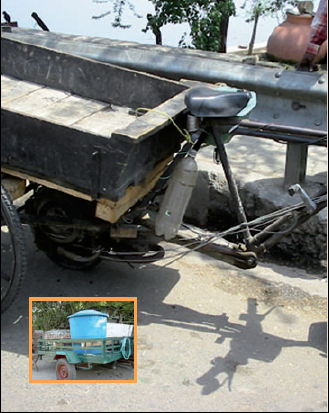Difference between revisions of "Cartage system"
Lagerstrom (talk | contribs) (inserting text) |
m (GvH testing editing settings...) |
||
| Line 1: | Line 1: | ||
[[Image:Cartage_systems_icon.png|right]] | [[Image:Cartage_systems_icon.png|right]] | ||
| − | Tricycles and push carts can be used to transport containers and oil drums containing urine or excreta. Push carts and tricycles (pedal or motorised) can access small streets. Tricycles can speed up the collection operation and increase the radius of the collection in urban areas, transporting the containers to transfer stations or to community treatment facilities. From transfer stations, urine and excreta can be loaded onto trucks or tractors, which can haul a larger volume over a long distance. Tricycles can collect door to door, although urine can also be collected in larger containers serving a number of houses. | + | 1 Tricycles and push carts can be used to transport containers and oil drums containing urine or excreta. Push carts and tricycles (pedal or motorised) can access small streets. Tricycles can speed up the collection operation and increase the radius of the collection in urban areas, transporting the containers to transfer stations or to community treatment facilities. From transfer stations, urine and excreta can be loaded onto trucks or tractors, which can haul a larger volume over a long distance. Tricycles can collect door to door, although urine can also be collected in larger containers serving a number of houses. |
[[Image:Cartage_systems.png|thumb|right|150px|[[Cartage system |Cartage system]], motorized tricycle in India (for credits, click the picture)]] | [[Image:Cartage_systems.png|thumb|right|150px|[[Cartage system |Cartage system]], motorized tricycle in India (for credits, click the picture)]] | ||
Revision as of 15:49, 1 October 2007
1 Tricycles and push carts can be used to transport containers and oil drums containing urine or excreta. Push carts and tricycles (pedal or motorised) can access small streets. Tricycles can speed up the collection operation and increase the radius of the collection in urban areas, transporting the containers to transfer stations or to community treatment facilities. From transfer stations, urine and excreta can be loaded onto trucks or tractors, which can haul a larger volume over a long distance. Tricycles can collect door to door, although urine can also be collected in larger containers serving a number of houses.
| Advantages | Disadvantages |
|---|---|
| Not dependent on large, cost-intensive infrastructure. Source of income for small private entrepreneurs. |
Highly depending on willingness to pay for regular removal of excreta. Only appropriate for small haul distances and small volumes. |
Costs
- Investment costs motorised tricycle - About US$ 300 (India, 2005).
- Yearly operation and maintenance costs for the collection of faeces of 8000 households with motorised tricycles (incl. labour costs) - About US$ 2000 (India, 2005).
Applying conditions
- Pushcarts and tricycles are especially appropriate in flat urban areas, with access roads.
- Pushcarts and tricycles are not appropriate for collecting large volumes (> 300 litre, > 300 kg) or for longer distances.
- Operators require training and regulation.
External links
- General information about Waterless urinals www.waste.nl
- General information www.bpdws.org
- General information www.sulabhinternational.org

